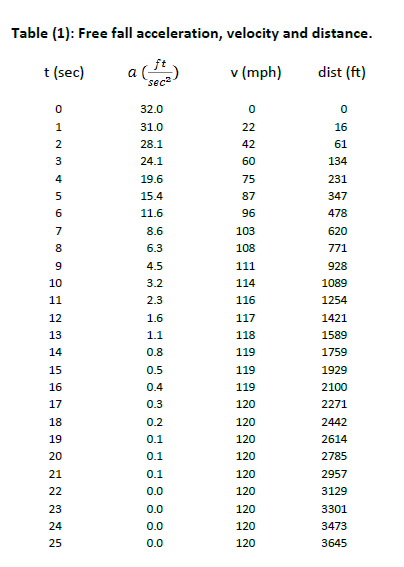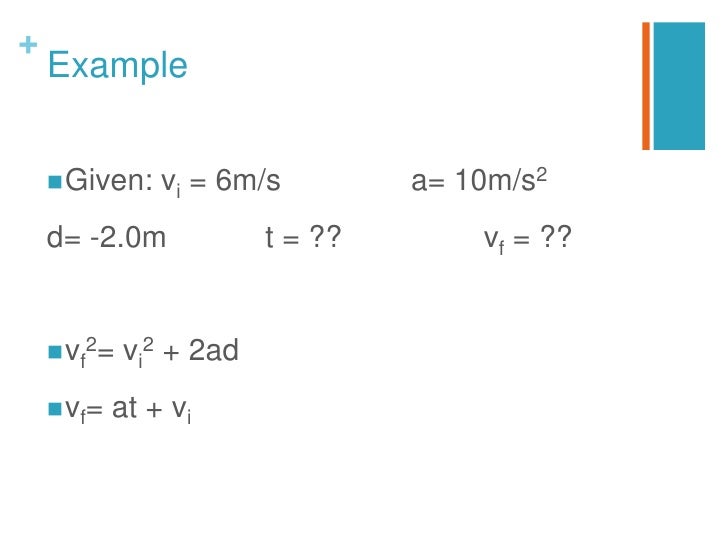

Solution: Now the initial velocity is unknown and the final velocity is zero. Determine the initial speed and the deceleration. Find the unknowns given final velocity, time, and distanceĮxample problem: An car decelerates for n seconds until it finally stops after traveling the distance of m meters. After that, you can plug the time into the next equation to find the final velocity:Ĭase 7.

Of course, to find the time you need to pick up the positive root. However, this case is quite complicated, because the only way to find the time is to solve the quadratic equation: Solution: Yet again the initial velocity is zero. Determine the liftoff speed and the time. Find the unknowns given initial velocity, acceleration, and distanceĮxample problem: An airplane accelerates down a runway at n m/s² until it finally lifts off the ground after traveling the distance of m meters. Note that here it is easier to find the final velocity first, then plug it into the second equation. The kinematic equations for this case are: Solution: In this problem, the initial velocity is zero as well. Determine the liftoff speed and the acceleration. Find the unknowns given initial velocity, time, and distanceĮxample problem: An airplane accelerates down a runway for n seconds until it finally lifts off the ground after traveling the distance of m meters. Here it is easier to find the time first, then plug the time into the second equation. And we use the kinematic equations like so: Solution: As usual we know that the initial velocity is zero. Find the unknowns given initial velocity, final velocity, and distanceĮxample problem: An airplane accelerates down a runway until it finally lifts off the ground having a speed of n m/s after traveling the distance of m meters. So, our kinematic equations will be:Ĭase 4. Solution: The same case with the initial velocity being zero. Determine the time and the distance traveled before takeoff. Find the unknowns given initial velocity, final velocity, and accelerationĮxample problem: An airplane accelerates down a runway at n m/s² until it finally lifts off the ground having a speed of m m/s. To solve the problem, we need to rearrange our kinematic equations like so:Ĭase 3. Solution: Again we know that the initial velocity is zero. Determine the acceleration and the distance traveled before takeoff. Find the unknowns given initial velocity, final velocity, and timeĮxample problem: An airplane accelerates down a runway for n seconds until it finally lifts off the ground having a speed of m m/s. Thus, we can use our kinematic equations as isĬase 2. The problem assumes that an airplane starts from the rest, hence, its initial velocity is zero. Solution: Although the problem specifies only the acceleration and the time, the third parameter is known implicitly. Determine the final velocity and the distance traveled before takeoff. Find the unknowns given initial velocity, acceleration, and timeĮxample problem: An airplane accelerates down a runway at n m/s² for m seconds until it finally lifts off the ground. Then, the value of $b$ can be easily determined.Below are ten types of problems along with the solution formulas. Suppose you release an object from a height $h$ (let) and it hits the ground in time $t$. The value of $b$ can be approximated by conducting an experiment and using the relation between $s$ and $t$. This relation is only approximate because in practical situations, $b$ does not remain constant for the whole journey.

Will the relation obtained between $s$ and $t$ follow the concept of terminal velocity? One question came to my mind while solving. Solve this as indefinite integration and obtain the value of integration constant by putting $s=0$ for $ t=0$. Now, I leave this integration for you to solve. Solving this for v in terms of t, we get.Īpplying the condition $v=0$ at $t=0$, we get $c=-g/k$ As mentioned in the comments, the resistive force is proportional to the velocity and let the constant of proportionality be $b$.


 0 kommentar(er)
0 kommentar(er)
